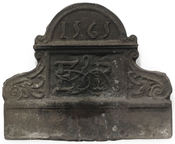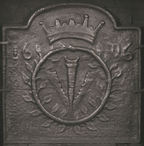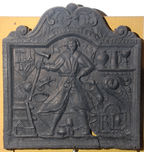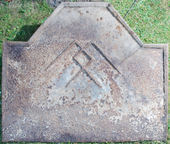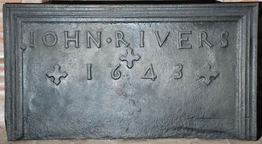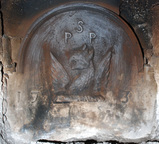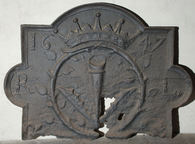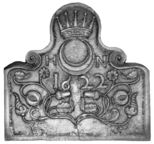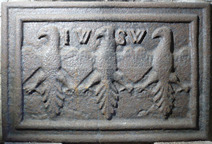-
815
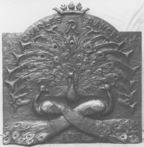 ? x ? mmImage subject to copyright
? x ? mmImage subject to copyrightDescription: Arched rectangular shape with crown, top centre; central peacock, its tail feathers displayed, with two other peacocks below, their tail feathers down; name across top of arch, split by initial, R; date ato bottom below tail feathers.
Notes: Manufactured by Seager's of Dartford, Kent
Inscription: CHARLES FRANCIS / R / 1967
- Decoration tags:
- rectangular with round arch (shape)
- none (edging)
- whole carved pattern
- pictorial
- text
- animals
Manufactured: in 1967 in England.
Current location: not known.
- Attached to series:
- Personal firebacks
-
261
Description: Plain rectangular bottom panel with fillet on top; above, rectangular panel with fillet and ovolo-moulded edging, within which the initials, ER, ornately carved, intertwined with floral tendrils; on each side, a scrolled bracket with double fillet edging, enclosing [?] ears of corn; on top, a narrow cornich, with an arch above, scrolled at each end and with double fillet edging, enclosing the date, possibly formed of individual stamped letters.
Notes: The 'ER' initials should not be assumed to be those of Elizabeth I. Formerly at Ockwells Manor, Cox Green, Berkshire. Christie's auction 4 Nov 2008 lot 259 (£3,750).
Copies of this fireback are known.
Inscription: 1565 / ER
- Decoration tags:
- rectangular with round arch (shape)
- complex individual (edging)
- whole carved pattern
- individual numbers
- text
- plants
Manufactured: in 1565 in the Weald area of England.
Current location: not known.
- Attached to series:
- Personal firebacks
- Date & initials firebacks
-
58
Description: Arched rectangular shape; cavetto edging; a pheon (a downward-pointing arrow head barbed on the inner edge), the badge of the Sidneys, within a wreath, an earl’s coronet above; the date on either side of the coronet.
Notes: The badge is of the Sidneys, Earls of Leicester. The date is most likely to be 1626 as the Earldom was not conferred upon Robert Sidney until 1618 and he died in 1626. A recast plate.
Inscription: 16 [?]26
Arms: Badge of Sidney family, Earls of Leicester
- Decoration tags:
- rectangular with round arch (shape)
- astragal (edging)
- whole carved pattern
- individual numbers
- heraldic
- text
Manufactured: in the early- to mid-17th century possibly at Robertsbridge Furnace, Salehurst in the Weald area of England.
Current location: Florence Court, Enniskillen, Fermanagh, Northern Ireland.
Museum number: 630836 (part of the National Trust museum group)
- Attached to series:
- Earl of Leicester series
- Personal firebacks
-
429
Description: Arched rectangular shape with symmetrical floral scrolls on top; three horizontal plank lines; ovolo moulding all round edge of main panel; inscription along top edge of panel; central figure of a bearded man wearing knee-length coat, belted at waist, and holding a sledge hammer in his right hand, his left arm akimbo; both feet pointing to his right; various ‘tools’ of his trade arranged about him; (clockwise from top left) shield, the quarters containing a masonry hammer, a firedog, a weight, and a pair of pincers; the date split on either side of his head; a floral console supporting a shelf bearing a flagon, a tankard and a goblet; a fireback bearing the letters RL and a diamond shape; from the top of the fireback a dog leaping up at its master; between the man's legs a long-handled ladle, a weight and a cooking pot; a ringer, used to pull slag off molten iron; part of the elevation of a blast furnace, with wooden framework, casting house, and flames issuing from the top; an ore basket, wheelbarrow and a charcoal clamp
Notes: The 'Lenard' fireback; a much-copied plate. Items relating to the founder's working life are displayed to the left of the figure, those to the right reflecting his domestic life. Its individualistic design and naïve figuration are the key to identifying a distinct group of firebacks, all probably made at Brede. A pastiche of this fireback also exists (no. 668), with which it is sometimes confused.
Copies of this fireback are known.
Inscription: RICHARD LENARD FOVNDER AT BRED FOVRNIS [each D is reversed] / 1636 / RL
- Decoration tags:
- rectangular with round arch (shape)
- ovolo (edging)
- whole carved pattern
- planklines
- pictorial
- historical
- text
- animals
- humans
- objects
Manufactured: in 1636 at Brede Furnace in the Weald area of England.
Current location: Anne of Cleves House, Southover High Street, Lewes, East Sussex, England.
Museum number: LH000.906 (part of the Sussex Archaeological Society museum group)
Citation: Anon., 30 Dec 1911, 'Sussex Backs and their Story', The Ironmonger.
Citation: Dawson, C., 1903, 'Sussex Iron Work and Pottery', Sussex Archaeological Collections, 46, pp. 1-54.
Citation: Gardner, J. S., 1898, 'Iron Casting in the Weald', Archaeologia, 56, 1, pp. 133-164.
- Attached to series:
- Brede group
- Personal firebacks
-
465
Description: Rectangular with three-faced arch; ogee moulded edging; top centre, overlapping, crossed staples arranged diagonally, each pointing to a bottom corner.
Notes: The crossed staple is the badge of the Nevill family, and this fireback came from Eridge Park, the seat of the Marquess of Abergavenny.
- Decoration tags:
- rectangular with three-facetted arch (shape)
- cyma reversa/ogee (edging)
- simple stamps
- heraldic
- objects
Manufactured: in the 18th century possibly in the Weald area of England.
Current location: in private hands, Little Horsted, East Sussex, England.
- Attached to series:
- Personal firebacks
- Metalware stamp firebacks
-
490
Description: Rectangular; multiple moulding on top and sides; inscription below moulding at top; three pointed crosses, one between inscription and date, one each side of date.
Notes: Purchased by J. H. Every in a sale at Groombridge Place, Kent in 1919. John Rivers was the husband of Isabella Packer, whose father Sir Thomas Packer, owned Groombridge Place. Bequeathed to the Sussex Archaeological Society in 1944.
Inscription: IOHN·RIVERS / 1643
- Decoration tags:
- rectangular (shape)
- complex, furniture-derived (edging)
- carved stamps
- individual letters
- individual numbers
- text
Manufactured: in 1643 in the Weald area of England.
Current location: Michelham Priory, Arlington, East Sussex, England.
Museum number: 1944.24.431 (part of the Sussex Archaeological Society museum group)
Citation: Hughes, G. B., 21 Apr 1955, 'Old English Firebacks', Country Life, 117, pp. 1056-60.
Citation: Hughes, G. B., May 1940, 'Old English Firebacks', Apollo, 31, 185, pp. 117-120.
- Attached to series:
- Date & initials firebacks
- Personal firebacks
- Miscellaneous stamp firebacks
-
501
Description: Arched rectangular shape; ovolo-moulded edging; central crest of a gryphon's head couped, its wings displayed; above, the initials, the 'S' above the 'P's; below, the date.
Notes: The crest is likely to be that of Peter Short of Lindfield, Sussex, who married Philadelphia Burrell in 1704.
Inscription: PSP / 1730
Arms: Short of Lindfield
- Decoration tags:
- rectangular with round arch (shape)
- ovolo (edging)
- carved stamps
- individual letters
- individual numbers
- heraldic
- text
Manufactured: in 1730 possibly in the Weald area of England.
Current location: in private hands, Newick, East Sussex, England.
- Attached to series:
- Personal firebacks
- Date & initials firebacks
- 1730s-40s, date & initial series
-
511
Description: Rectangular with semi-circular protrusions on the top and sides; cavetto edging; a pheon (a downward-pointing arrow head barbed on the inner edge), within a wreath, an earl’s coronet above; the date on either side of the coronet; the initials on left and right sides; a fleur de lys in each bottom corner.
Notes: The wreathed pheon and coronet are cast from a different pattern to the 1626 and 1630 plates.
Copies of this fireback are known.
Inscription: 16 47 / R L
- Decoration tags:
- rectangular with round arch (shape)
- cavetto (edging)
- whole carved pattern
- planklines
- heraldic
- text
Manufactured: in 1647 possibly at Robertsbridge Furnace, Salehurst in the Weald area of England.
Current location: Penshurst Place, Penshurst, Kent, England.
- Attached to series:
- Earl of Leicester series
- Personal firebacks
-
584
Description: Of unique design; quasi-arched rectangular shape; ribbon border, curled on each side of the neck. Symmetrical arrangement of plant tendrils with acorns, oak leaves, pomegranates and other leaves across the rectangular base; above and centrally placed are the date, over which are the initials either side of a crescent moon, surmounted by an earl’s coronet.
Notes: The initials, H N, are thought to refer to Henry, 9th Earl of Northumberland, and the date to his release from the Tower of London following his 17 years’ imprisonment for alleged involvement in the Gunpowder Plot.
Copies of this fireback are known.
Inscription: H N / 1622
- Decoration tags:
- rectangular with round arch (shape)
- complex individual (edging)
- whole carved pattern
- heraldic
- text
- plants
Manufactured: in 1622 probably at Frith Furnace, Northchapel in the Weald area of England.
Current location: Petworth House, Petworth, West Sussex, England.
Museum number: 485698 (part of the National Trust museum group)
- Attached to series:
- Personal firebacks
- Petworth lettering series
-
1160
Description: Rectangular, with double astragal edging; three eaglets, their wings outspread, side by side; the initials IW and SW, respectively, to left and right of the central eaglet's head.
Notes: The design is based on the arms of Wynn, of Gwydir Castle in the Conwy valley of North Wales, the blazon of which is Vert, three eagles displayed in fess or. The initials relate to Sir John Wynn (1553-1626/7) who, c.1576, married Sydney Gerrard (d.1632), dating the fireback to c.1576-1626. The conjoined wings of the eagles appear to form heart shapes.
Inscription: IW SW
Arms: Wynn of Gwydir
- Decoration tags:
- rectangular (shape)
- astragal (edging)
- whole carved pattern
- individual letters
- heraldic
- text
- animals
Manufactured: in the late-16th to early-17th century in England.
Current location: Gwydir Castle, Trefriw, Conwy, Wales.
- Attached to series:
- Personal firebacks
- Welsh armorial firebacks
